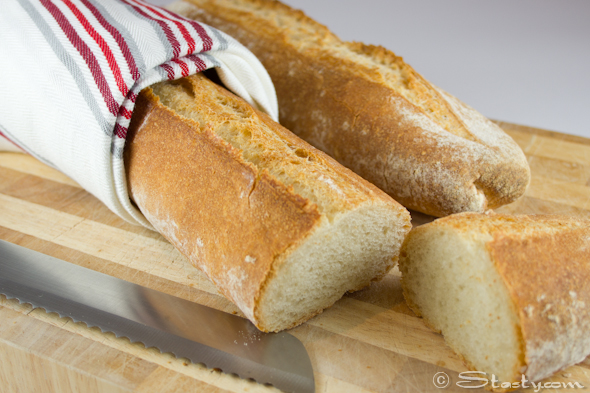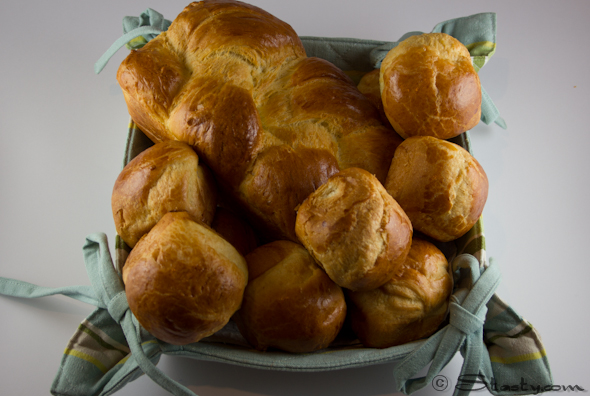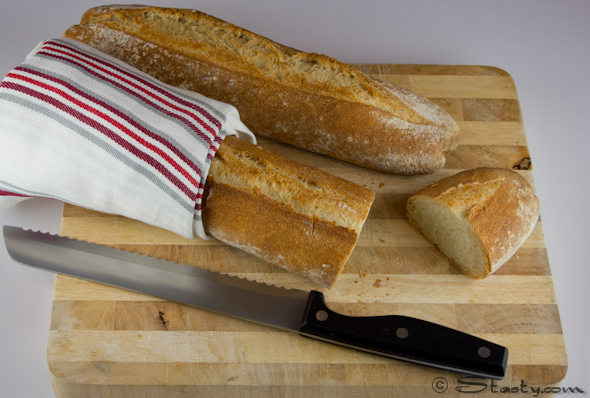
Recently I did a fantastic French bread making course. I’ve always wanted to make my own French baguette as it’s so hard to get a decent baguette in Ireland. So this course seemed like a perfect way to spend my Saturday, kneading and dreaming about la vie en France. We arrived on the dot at ten and our eager teacher was already dressed in his whites and jaunty baker’s hat. This course definitely isn’t for the faint hearted. It was go go, knead knead, and prove, prove from the outset.
We started off by making the dough for a classic French baguette. At the start it seems simple enough, easy instructions and just a few ingredients. French Baguettes are made with Poolish which is a yeast starter. The polish is mixed with fresh baker’s yeast, strong white flour, salt, and water. The hard part about making French bread is definitely the kneading. We started kneading and were all very enthusiastic and full of energy. Soon we had shiny brows, next the jumpers came off, and then the arms began to ache. Suddenly I noticed I was standing funny, I was literally putting my entire weight into kneading the bread. Though we had been taught how to knead, we had all quickly developed our own different techniques 🙂 Some were slapping the dough off the table as they kneaded, others were pulling it in all directions, and we were all trying to get as much air into the dough as humanly possible.
The baguette was then left to prove (first proving!). Meanwhile we made a start on the tarte flambée, which is thin pizza like base with a sour cream, lardon and onion topping. The kneading of this one was somewhat easier, given that there was less dough and we were a little more used to it. The tarte flambée didn’t need proving so instead we rolled it out thinly and covered it with our delicious topping. Yum. This went straight into the oven.
The waft of tarte flambée cooking in the oven nearly drove us all mad, as we ploughed on and made a fougasse which is French cheese bread. Having kneaded this one, it was left to prove and we started to knock back our baguette dough. After this, the dough was left to prove for a further fifteen minutes before being knocked back again. It was finally rolled into four loose rolls and placed in a couchette (a linen tea towel, folded just so). It was then left to….you’ve guessed it…prove again.
Having taken the tarte flambées out of the oven we rolled out the cheese fougasse and then put them in the oven. We only had time for a very quick tea break before moving onto the brioche. It was pretty hard to keep going given the delicious smells emanating from the ovens and our rumbling stomach, but on we went.

I LOVE good brioche, it’s my favourite weekend breakfast treat. There is one amazing bakery in Dublin called Panem which make fantastically good ones. But here I was, finally learning how to make my own. The realities of making brioche made me realise very quickly that it is ridiculously bad for you. It’s kind of like a loaf shaped coronary. Our recipe used 6 eggs and over a half a pound of butter. The dough for this one was extremely messy and wet. It looked like a massive gooey yellow mess on the table. It stuck to everything, the table, my hands, and the dough scraper. Just as I was getting confident with the kneading, I was back to feeling like a helpless child with a sticky mess on my hands. We persevered and kept kneading. There are no sneaky sprinkles of extra flour in this class, it’s all about using the exact ingredients and making it work. It’s a good way to work and does give you great discipline. We finally got our brioches into manageable lumps, and then left it to prove. The Fougasse were then taken out of the oven and placed on a wire rack to join the tart flambé.
No rest for the wicked however, (the only ones getting any rest here was the bread!) The baguettes were gently roused from their couchette, tucked up and rolled into neat cylinders with pointy ends. There are no machines to make the pointy ends, so you’ll always no a good hand-made baguette by the distinctive pointy end. We dusted the baguettes with a mere sprinkle of flour and drew a line on the top with a knife, before popping them into the oven for the final cooking.
Meanwhile the brioches were knocked back, proved, and divided up into neat little buns and a small plaited loaf. Phew! We all then sat down and finally did a bit of resting ourselves. Meanwhile our tireless teacher regaled us with historical tales of French bread- making and its origins. This course certainly manages to pack a wealth of information in one day.
By now we had produced some golden beauties. It was such a rewarding day. We came home with box loads of bread! It was a hard working day but oodles of fun. I paid for this course myself and have no connection with the organisers, but I would be more than happy to recommend this course to anyone interested in bread making. For more information about The Baking Academy of Ireland course see their website.

